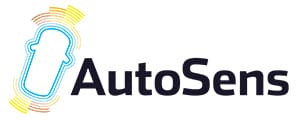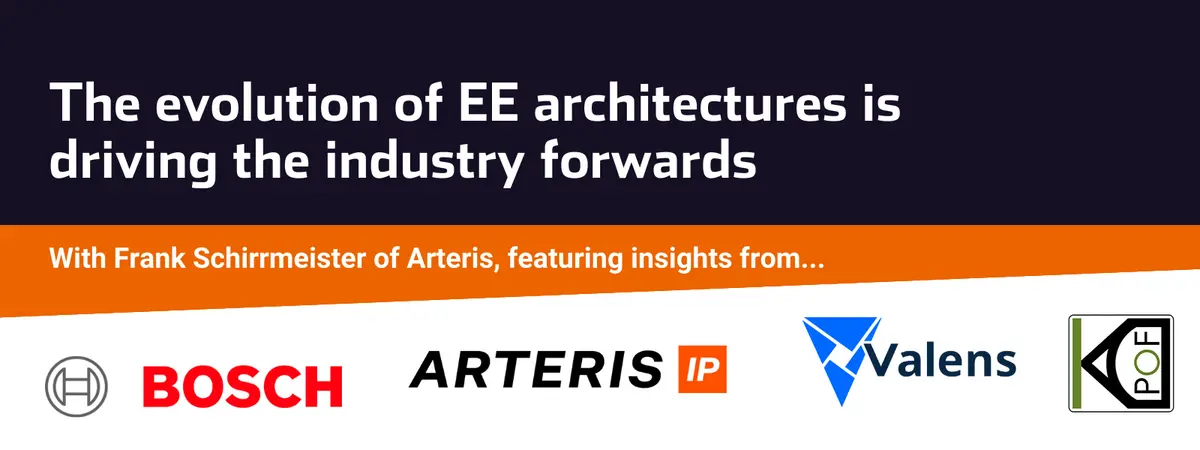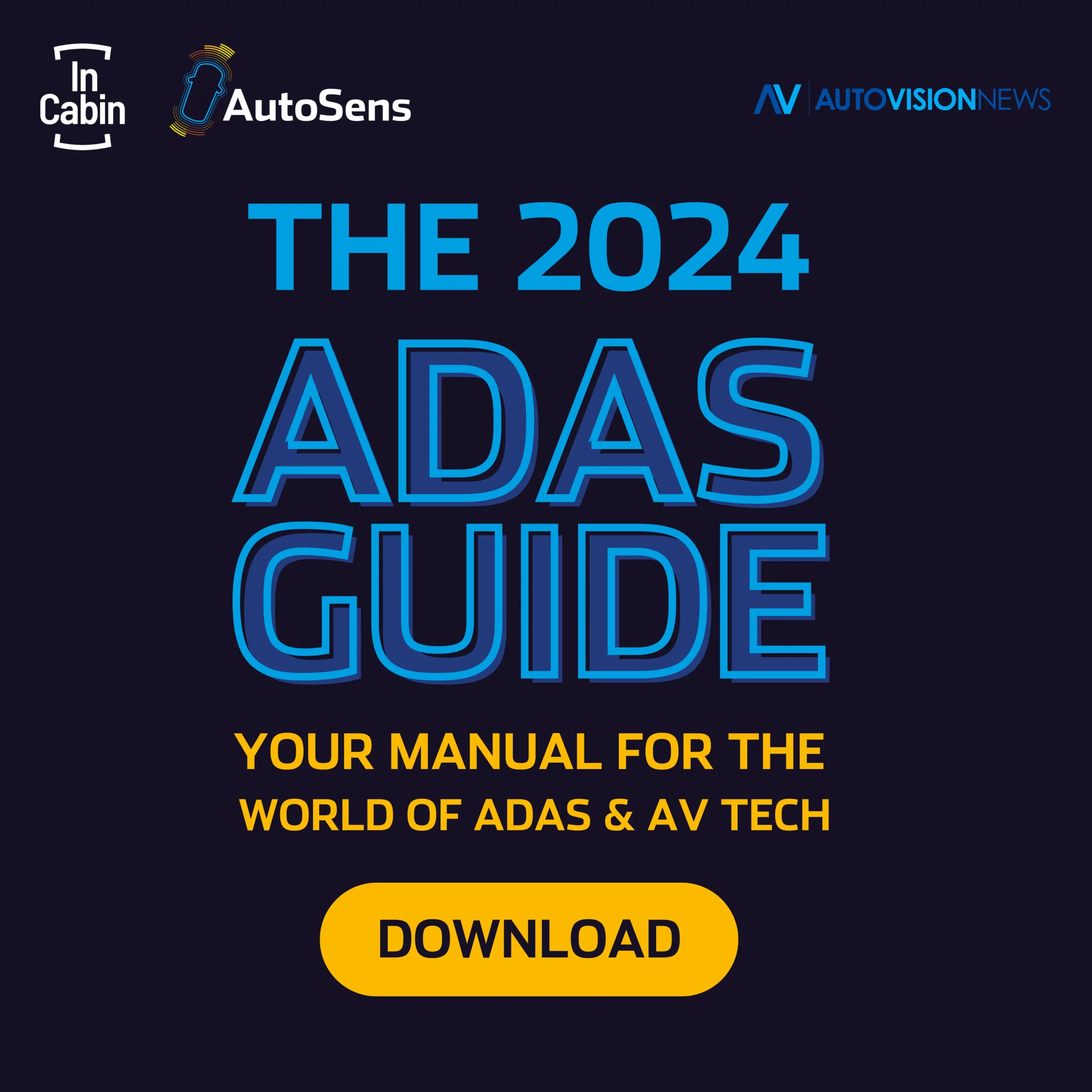The automotive industry has become a key driver of semiconductor innovations. It is at the cusp of a significant transformation, driven by advancements in artificial intelligence (AI), machine learning, and a shift towards more integrated and intelligent vehicle systems. The evolution of automotive Electrical/Electronic (E/E) architecture is central to this transformation, and we are witnessing this, particularly watching the trends towards centralized computing, software-defined vehicles, and enhanced connectivity solutions.
Ahead of key discussion on this topic at AutoSens USA in May, we asked Frank Schirrmeister, Vice President of Solutions and Business Development at Arteris and AutoSens Advisory Board Member, to share his thoughts on this shift in the industry. Plus viewpoints from experts at Bosch and KDPOF.
Frank Schirrmeister
Vice President of Solutions and Business Development
Arteris

Charting the Trend Lines
While historically, vehicles have relied on multiple electronic control units (ECUs) to manage various functions, the future points towards a more consolidated approach. Eventually, a few central vehicle computing engines are widely expected to handle multiple system functions previously managed by separate domains. This shift is made possible by integrating diverse functionalities into systems on chips (SoCs) or systems of chiplets integrated into single packages. The benefits of such an approach include reduced complexity, enhanced performance, and increased flexibility in software updates and system upgrades, ultimately leading to improved consumer experiences.
While exact timelines and intermediate steps are hard to gauge, figure 1 shows an example evolution of E/E architectures suggested by NXP (Source: https://bit.ly/43blr5q).

Autosens USA this May this year will feature several sessions specifically looking at future automotive E/E architectures in this context. A couple of topics stick out as central themes:
The Dawn of the Software-Defined Vehicle
At the heart of the automotive industry transformation is the emergence of the software-defined vehicle, a concept that envisions cars not just as modes of transport but as integrated platforms for digital life. This evolution hinges on centralizing computing within the vehicle, leveraging advanced semiconductor technology to condense what was once managed by numerous electronic control units (ECUs) into a few or even a single central processing unit. This consolidation can offer unprecedented levels of flexibility, scalability, and upgradability. Vehicles are becoming platforms for continuous improvement and customization, much like smartphones have evolved over the past decade.
Related News: Intel’s softare-defined vehicle delivers efficiency and performance
Conquering Connectivity and Bandwidth Challenges
As vehicles transform into mobile data centers, the challenges of managing increased connectivity and bandwidth demands come to the forefront. Autonomous driving systems (ADAS), with their reliance on high-resolution sensors and real-time data processing, underscore the need for robust, high-bandwidth communication systems. Developing and implementing innovative compression technologies and data transport protocols are critical in ensuring that these complex systems can communicate efficiently, reliably, and safely. Solutions such as JPEG XS demonstrate how the industry addresses these challenges, offering low-latency, high-quality video compression to manage the deluge of data generated by vehicle sensors.
Related News
– Car sensor market update from Electronics Weekly
– Five automotive connectivity trends fueling the future
Optimizing Data Transport for Next-Generation Automotive Systems
The shift towards more intelligent and autonomous vehicles requires never-before-seen requirements for optimization of data transport within automotive SoCs. The challenge of navigating the ‘memory wall’—the bottleneck in data access and transfer speeds—requires reimagining data transport architectures. Networks-on-Chips (NoCs) and related advanced protocols like AMBA AXI, ACE, and CHI are at the forefront of this innovation, enabling more efficient, flexible, and high-performing automotive SoCs. These technologies support the demanding requirements of automotive AI and embedded vision systems and adhere to the stringent safety standards critical to vehicle design.
Integrating ADAS with In-Vehicle Infotainment and Monitoring
An intriguing aspect of automotive E/E architecture evolution is the integration of ADAS functionalities within the In-Vehicle Infotainment (IVI) and Monitoring domains. This integration signifies a move towards more centralized computing solutions, where a single chip can handle diverse tasks, from multimedia entertainment to complex ADAS algorithms. This convergence of functionalities reduces costs, simplifies system design, and enhances the overall vehicle experience by creating a more cohesive interaction between the driver, the vehicle, and the environment.
Related News
– Ford launches Digital Experience for advanced connectivity and infotainment
– Bosch unites infotainment and driver assistance functions on one chip
The Critical Role of Partnerships in Driving Innovation
With its intricate design chain of OEMs, Tier-1, and Tier-2 suppliers, the automotive industry has always been complex. Today, the evolution of automotive E/E architecture is not just a technical challenge but also an ecosystem-wide endeavor. Integrating technologies across domains requires deep partnerships between chip manufacturers, software developers, automotive OEMs, and other stakeholders. These collaborations are pivotal in fostering innovation, speeding up the development process, and ensuring that new technologies can seamlessly integrate into automotive systems. By working together, the industry can overcome technical challenges and regulatory hurdles, paving the way for vehicles that are smarter, safer, and more aligned with the future demands of automotive electronics. Great examples of how partnerships can facilitate innovation are the integration of Synopsys’s AI IP into SiEngine’s SE1000 chip or the Arm/Arteris partnership, offering a glimpse into the future where vehicles are more autonomous and more integrated with our digital lives.
Want more on this?
Check out this panel session featuring Frank, discussing what value can be driven through working together in the automotive supply chain.
Outlook
The automotive industry’s shift towards centralized computing, software-defined vehicles, and optimized data transport architectures represents a significant paradigm shift. This evolution, powered by advancements in semiconductor technology, AI, and connectivity solutions, promises to deliver safer, more efficient, and more enjoyable driving experiences. However, realizing this future will require continued innovation, collaboration, and a commitment to integrating complex technologies seamlessly and safely within the automotive domain.
AUTOSENS USA 2024 AGENDA SESSION
OPTIMIZING DATA TRANSPORT ARCHITECTURES FOR AUTOMOTIVE AI, ADAS, AND EMBEDDED VISION SYSTEM-ON-CHIP (SOC) ARCHITECTURES
Frank Schirrmeister
Vice President of Solutions and Business Development
Arteris


Speaker Insight
Auston Payyappilly
Sr. Manager Product Management

How do you envision the evolution of centralised architectures and ECUs to support ADAS and AVs in terms of scalability, efficiency, and safety?
The evolution of centralized architectures and ECUs for ADAS involves adopting modular designs and integrating functions and features that run on high-performance computing devices with optimized algorithms. A centralized architecture also addresses the need for edge computing by providing lower latency and advanced sensor fusion techniques for data perception. Centralized architectures can also enhance safety by providing a more efficient approach to processing sensor data, which ensures consistent, safe and reliable responses across various driving scenarios. Collaboration across the industry and advancements in semiconductor technologies will all contribute to shaping the future of vehicle architectures.
Related News from Bosch: Vehicle-centralized, zone-oriented E/E architecture with vehicle computers
Why is it crucial for industry leaders like Bosch to actively engage in forums such as AutoSens and InCabin to discuss advancements and challenges related to this, and how does this collaboration benefit the development of automotive technology?
For an automotive supplier like Bosch, collaborating and engaging in industry events is critical. These events support networking, knowledge sharing, and collective problem-solving. Platforms like AutoSens and InCabin facilitate this exchange enabling innovative companies to collectively address complex challenges and stay close to rapidly evolving automotive technologies. Participation in these forums also allows industry stakeholders to contribute to the development of industry standards and regulations, thereby shaping the future. Beyond these benefits, active involvement can also enhance a company’s visibility and reputation, which helps attract talent, partners, and customers.
AUTOSENS USA 2024 AGENDA SESSION
SYSTEM ON CHIP (SOC) FOR THE SOFTWARE DEFINED VEHICLE
Auston Payyappilly
Sr. Manager Product Management
Bosch


Speaking Company Insight

What are the technical limitations and performance bottlenecks associated with a centralized architecture for ADAS/AVs, and how do industry practitioners mitigate these challenges?
The holy grail of in-vehicle architecture is definitely centralized, but there are a number of issues holding the industry back, one of which is connectivity. Until recently, many sensors have included processing elements within the devices themselves, which then send along low-bandwidth, pre-processed data. Removing the processing elements from these devices would place immense pressure on the connectivity solution, which would need to transmit high-bandwidth data over long distance, while maintaining near-zero latency.
How do technologies such as CAN (Controller Area Network) and Ethernet influence the integration and communication protocols of exterior sensing technologies like LiDAR and radar within autonomous vehicle architectures? Are there other, more efficient options available?
CAN is a low-bandwidth interface that is not appropriate for high-resolution ADAS sensors. Ethernet is a symmetric interface – perfect for applications like infotainment, which require the same amount of bandwidth being transmitted in both directions. But for ADAS and ADS systems, which demand highly asymmetric connectivity, Ethernet is not an appropriate technology.
A more efficient option for asymmetric connectivity is MIPI A-PHY, a long-reach, high-speed interface that can support multiple protocols and sensors. MIPI A-PHY is designed specifically for the automotive industry, addressing the challenges of reliability, scalability, interoperability, and security. By using MIPI A-PHY, automakers and suppliers can reduce the complexity and cost of wiring, harnessing, and shielding, while enabling higher performance and functionality. MIPI A-PHY is gaining traction as the industry standard for in-vehicle connectivity, with market-leading companies adopting and endorsing it.
AUTOSENS USA 2024 AGENDA SESSION
BRIDGING THE INFRASTRUCTURE BANDWIDTH CHALLENGES FOR CENTRALIZED IN-VEHICLE ARCHITECTURES
Daniel Shwartzberg
Director of Automotive System Solutions
Valens


Want more from Valens?
Check out this interview with Daniel from AutoSens USA 2023, discussing the release of industry’s first MIPI A-PHY compliant chip sets.
Speaker Insight
Rubén Pérez-Aranda
CTO

The centralized architectures utilized in ADAS/AV necessitate significant data transmission from sensors to AI central computing units (e.g. 3 to 10 Gb/s), which is crucial for environment perception around the vehicle.
Connecting each sensor directly to the AI unit is impractical due to constraints such as cable complexity, cost, size, and weight. To address this, a data network is deployed throughout the vehicle, aggregating sensor information per zone (zonal ECUs), which is then relayed to the AI units. However, transitioning from point-to-point links to a network like Ethernet introduces new requirements for underlying physical layers.
Data aggregation amplifies data rate requirements per link (e.g. 10 to 25 Gb/s), and data compression is ineffective due to increased latency and potential degradation in precision. Legacy electrical physical layers using coax and balanced cables face limitations such as high insertion loss (e.g. ~40 dB at ~10 GHz, for 10 meters length) and return loss, leading to signal integrity and electromagnetic compatibility (EMC) issues. Even with digital signal processing (DSP) and forward error correction (FEC), which implies extra power consumption and latency, and EMC countermeasures, which imply extra cost, these problems worsen over time due to aging from thermal and mechanical cycles, making electrical solutions inadequate for future scalability.
In this scenario, optical links emerge as a viable solution, offering superior EMC performance, low power consumption, and scalability for future data rates. Bend-insensitive multimode fiber like OM3, utilized in automotive optical multi-gigabit applications, supports high bandwidth (i.e. 3dB at 20 GHz) over considerable distances (e.g. 40 meters) without electromagnetic interference concerns. Optical fiber also proves beneficial for larger vehicles like trucks and buses, where sensor-to-AI unit distances are greater.
While optical fiber interconnects are prevalent in telecom and data center environments, automotive applications require additional performance attributes such as broader operating temperature ranges, heightened reliability, and specific dependability and safety features. Addressing these needs, the IEEE Std 802.3cz standard was published in March 2023, supporting data rates of 2.5, 5, 10, 25, and 50 Gb/s (single lane) and enabling implementations qualified per automotive standards like AEC-Q100 grade 2.
AUTOSENS USA 2024 AGENDA SESSION
AN OPTICAL NERVOUS SYSTEM TO INTERCONNECT SENSORS AND ARTIFICIAL BRAINS IN AV
Rubén Pérez-Aranda
CTO
KDPOF


Connect on this topic in the exhibition
AutoSens and InCabin include a technology exhibition with an array of technical demonstrations, vehicle demonstrations, buck demos from world leading companies. Engineers who come to AutoSens and InCabin have the opportunity to not only discuss the latest trends but actually get their hands on the tech and see it in action.
Ready to join the adventure and dive into the technical world of ADAS and AV technology? Our USA exhibition will feature all these companies and more at the cutting edge of this technology.










